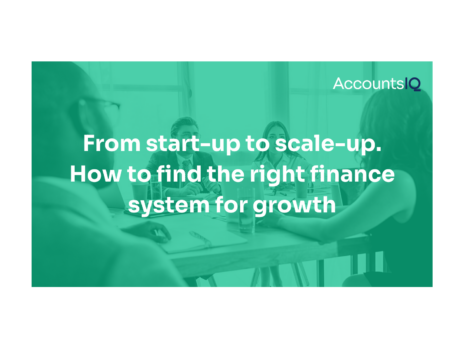
If there was ever a time in history when the importance of building flexibility into one’s systems was abundantly clear, it’s been over the last two years. The pandemic has had a disruptive impact on all aspects of business, including supply chains, recruitment, sales, customer retention, and working practices.
As the world started to return to a semblance of normality, the outbreak of war on a scale Europe had not witnessed since 1945, and inflation hitting its highest level in decades, has only served to emphasise that we are still living in an age of uncertainty and disruption.
In such an environment, the importance of maintaining a robust finance function, able to adapt and evolve as events unfold, is clear.
Educating decision makers
The Institute of Management Accountants found that, of the 1,481 businesses who said they had changed the priorities of their finance function during 2021, the highest proportion (44%) switched focus to ‘risk management’ while over a third (34%) admitted to spending less time on crucial finance functions like business partnering and decision support.
According to Darren Cran, COO of cloud-based accounting platform AccountsIQ, the growing need for firefighting is clear evidence that upgrading the finance function has been neglected by some businesses. A lack of education around basic principles, such as the value of APIs, has led to a lack of preparedness during global crises and has exposed the need for more connectivity among departments; especially when it comes to finance.

“The problem isn’t the technology,” Cran says. “The technology to make the finance function more efficient across business is already available. It just hasn’t been widely implemented yet. I’m talking about automation, and in particular, automated capture.
“If you understand that every business transaction ends up in a finance system, then you understand that those transactions are settled, and once they’re settled, there’s a contractual obligation between business and customer which manifests as invoices settled monthly, quarterly or annually. Those same businesses are then taking in contracts from their suppliers, so you can imagine the chaos when you realise that these finance functions, for whatever reason, are still being handled manually.”
Cran says that most global businesses tend to link up their data siloes using peer-to-peer connectivity, which then leads back to a centralised database in their finance function. The problem is that with the complexity this creates, many businesses still don’t have an API in operation; somewhere where all of a company’s information is collated and immediately accessible.
KPMG reports that implementing a robust API into an organisation’s finance function can cut general accounting costs by 45%, reduce manual reconciliations by 50%, and improve working capital by 15%. The question is why such digital solutions are not yet being adopted as standard.
“Some traditional industries such as accountancy are very tech-averse and many decision-makers wouldn’t know what an API is let alone how it can improve their business. In that sense, education is key,” says Cran.
“Enabling automation, adding codification against transactions, capturing information automatically, adding coding layers, all of these abilities which are facilitated by API-enabled FMS systems makes data more reliable.”
Choosing the right API
One way for businesses to start preparing themselves for API implementation, according to Cran, and begin the process of future-proofing, is to hire data analysts. Some businesses may not need full API functionality or integrations right away, and it can be hugely beneficial to have staff members in-house who can assess that specific business’s digital finance needs.
Increasing awareness of APIs among decision-makers and hiring knowledgeable members of staff also has the benefit of demonstrating the antiquatedness of on-premises storage systems. For reasons of security, maintenance and staff costs, difficulty integrating, and hampering growth, making the switch to cloud is a crucial aspect of the future-proofing process. But it is important to choose a platform with the ability to scale.
“What businesses find is that when they put off the change they need, it ends up being hugely costly and inefficient,” says Cran. “Of course, there is often no tangible way of measuring just how costly, but what we do know is that it’s very expensive to stay on a system that’s not fit for purpose. Wasting staff time by tying them up in unnecessary admin, inefficient use of senior people’s time.
“Even if your business is on a system that allows for basic compliance, the difference between that and a system which allows for both the interconnectivity of data and a richer well of information is enormous. The more two-dimensional systems aren’t able to tell a story with numbers in a way that a more sophisticated platform can.”
Once connectivity has been achieved across an organisation, the digitalisation process can be implemented. Cran recommends installing a platform with an SQL database and a cloud infrastructure which elastically allows for rapid expansion, as opposed to a more two-dimensional platform which delivers compliance reports and nothing else.
At the same time, Cran is keen to stress that more granular APIs at the top end of what’s available on the market can be expensive. And because not all businesses are at a level where they can expense from budgets, that cost invariably gets passed onto the customer.
“Part of what AccountsIQ is trying to do is to break the reluctance of small to medium-sized businesses when it comes to technology,” he says. “To show them that these platforms are there to supplement work functions, not replace them. To free up some of the more tedious administrative aspects of the finance function, and allow teams to commit to the kind of quality work they want to be doing.”
The future of the finance function
Of course, automation of the data capture process, connecting company bank accounts, and integrating apps which allow for real-time reporting are all further important aspects of future-proofing a business’s finance function. In this, Cran sees AI in particular as playing a crucial role, since it is a technology which is versatile, multi-purpose and relatively easy to integrate into existing platforms.
“AI is relevant in the sense that it can be embedded into FMS systems,” he says. “We’re already seeing its implementation in things like the creation of rule-based scenarios or certain aspects of the finance function which can be auto-processed and auto-coded. Some of the more interesting AI potentialities include use of voice – for example, in the running of reports, or instructing systems to run previous data entries.
“We’re also looking to introduce embedded banking into our products, which can ultimately provide more detail, automated processing, and organising patterns contained within complex data. Something like that could potentially be used to predict fraud by picking up on user behaviour and providing early warning signs that something is amiss.”
Ultimately, what Cran wants to see is more education of the decision-makers in charge of maintaining the finance function, since only they can know exactly what their businesses need. This requires hiring data analysts, de-stigmatising technology platforms in traditional industries, and knowing where to look when it comes to choosing the right API. Something cost-effective, multi-purpose, and with the potential to scale as businesses grow.








